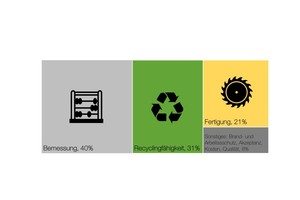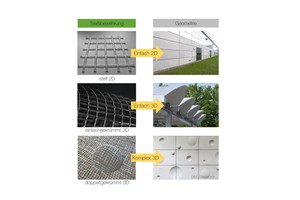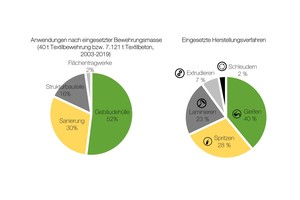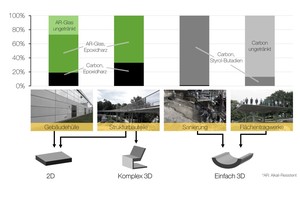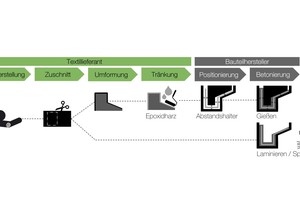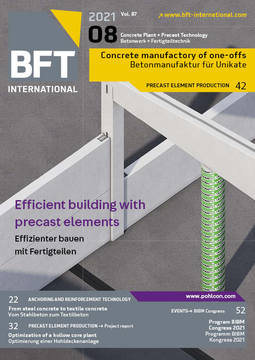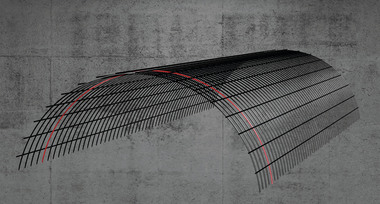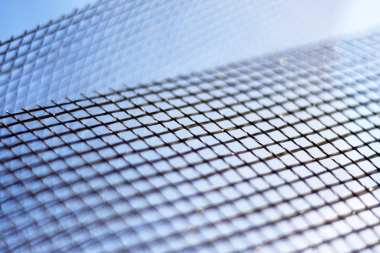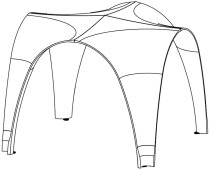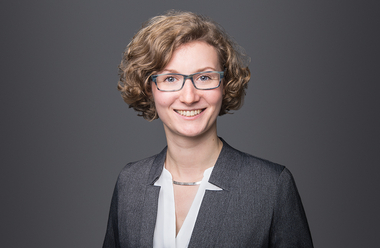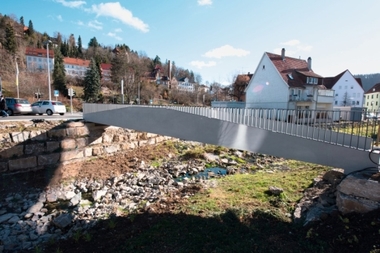From steel concrete to textile concrete –
how to get there?
There is an increase in the use of textile-reinforced concrete in Germany. Switching from steel-reinforced concrete is not entirely easy, however, since textile reinforcements made of glass fibers and carbon fibers have different requirements in terms of processing, design and recycling. The major challenges were identified in a survey conducted by the Institute of Textile Technology (ITA).
Joint research with and advanced education for companies – there is an increase in the use of textile-reinforced concrete in Germany. However, switching from steel-reinforced concrete to the new material is not entirely easy. Textile reinforcements made of glass fibers and carbon fibers have different requirements in terms of processing, design and recycling than the well-known structural steel. The major challenges were identified in a survey conducted by the Institute of Textile Technology (Institut für Textiltechnik; ITA) at RWTH Aachen University, and the results were used to draft a technical seminar which supports companies during introduction.
Designing textile-reinforced concrete to meet production, application and recycling requirements
The environmental burden caused by structures keeps increasing. 8% of greenhouse gas emissions is caused by cement production, 40% of total energy consumption in Germany is caused by building use, and 90% of the mineral resources used is processed in the construction sector. This leads to increasingly strict legal requirements.
Lightweight construction materials such as textile-reinforced concrete (“textile concrete” or “carbon concrete”) offer a solution towards reducing raw material consumption. Textile reinforcements based on glass fibers or carbon fibers are clearly superior to conventional steel-reinforced concrete, since the strength of fibers exceeds that of steel by a factor of two to six. Textile-reinforced concrete can therefore be used to produce thin-walled, load-bearing and non-corrosive structures that have a significantly longer service life than steel-reinforced concrete and require up to 80% less concrete and cement. As a result of these savings, textile-reinforced concrete is not only more CO2-efficient to produce than conventional steel-reinforced concrete but, due to its lower weight, is also more efficient in transportation, handling and installation, thus reducing associated transportation, labor and machine costs.
However, when switching from steel-reinforced concrete to a new material such as textile-reinforced concrete, questions arise that need to be answered:
Which applications and products are suitable for the use of textile-reinforced concrete?
What exactly is textile-reinforced concrete made of?
What textile reinforcements and types of concrete are used?
How expensive is textile-reinforced concrete?
What differences must be considered in the production of textile-reinforced concrete compared to steel-reinforced concrete?
What must be borne in mind when processing and handling the textiles?
Is a technical approval required?
How can textile-reinforced concrete be recycled?
All of these questions can be answered based on the current state of technology and science. Interested companies will have an opportunity to gain a condensed insight into the production methods and production planning of textile-reinforced concrete in a technical seminar held at the Institute of Textile Technology (Institut für Textiltechnik) of RWTH Aachen University on September 14 and 15, 2021. Further information has been compiled at the end of this article.
Current typical manufacturing routes and their challenges were identified in order to be able to offer transparent support to interested companies in the introduction of a new technology. To this end, data pertaining to construction projects with textile-reinforced concrete dating back to 2003 were researched, documented and evaluated. In addition, a survey was conducted among architectural firms, construction companies, producers of textile reinforcements, and manufacturers of textile-reinforced concrete who have already acquired working experience.
Survey among construction companies and precast producers
A survey was also conducted among German research institutions focusing on textiles and textile concrete. A total of 47 companies and research institutions participated in the survey, with 57% of participants coming from the industrial sector. The major portion of reinforcement textiles (52%) is currently used in the building envelope sector (see Fig. 1, left), followed by the refurbishment of steel-reinforced concrete structures (30%).
The data base and survey results show that, depending on the field of application and building element geometry, different manufacturing methods result in building practice, each of which places different requirements on the geometry and formability of the textile reinforcement. A significant correlation was thus found between the textile reinforcement used and the desired geometry of the building element (see Fig. 2 and Fig. 3). Stiff, resin-impregnated reinforcements made of glass fibers and carbon fibers are used in particular in the building envelope sector, where simple 2D geometries are frequently prevalent. Reinforcements impregnated with epoxy are also used for structural building elements, which usually require high strengths.
Flexible textile reinforcements with styrene-butadiene impregnation can also be used for simple 3D-curved building elements in the fields of refurbishment or shell structures. Non-impregnated textiles, on the other hand, are no longer relevant today, but were used mainly in the early days of textile-reinforced concrete until 2010.
The manufacturing routes of structural building elements with complex 3D geometries, however, such as those shown schematically in Fig. 4, are usually quite different from those of simple 3D and 2D building elements. A detailed analysis of the intended building element requirements, and production planning derived from the results, is therefore indispensable.
Across all fields of application, the construction contractors and precast producers interviewed as part of the survey have indicated that 91% of their building elements are manufactured in a manual process. The construction contractors and precast producers interviewed produce 40% of their building elements using the casting process, 28% of their building elements using the injection molding process, and 23% of their building elements using the laminating process (see Fig. 1, right). Machine production is divided into 7% extrusion and 2% centrifugal casting.
New DAfStb guideline almost completed
The survey also provided a comprehensive picture of the challenges currently perceived by both industry and science in relation to textile-reinforced concrete (see Fig. 5). The participants interviewed in the survey see the greatest deficits in reinforcement design, primarily in the lack of standards and norms. Fortunately, this situation is expected to be remedied shortly: work on the new DAfStb guideline entitled “Concrete building elements with non-metal reinforcement” (Betonbauteile mit nichtmetallischer Bewehrung) is almost complete.
Deficits are also seen in terms of recyclability. Users, manufacturers and recycling firms have virtually no information on how to recycle waste products, even though possibilities and technologies do already exist: easy recycling is made possible by the choice of textile reinforcement during the product design stage. The more robust the textile, that is, the larger the cross-section of the yarn, and the lower the chemical bond between textile and concrete (e.g. when using epoxy-impregnated textiles), the better the separability of concrete and reinforcement. In this way, in excess of 90% of the textile reinforcement can be recovered. The remaining fiber content in the mineral aggregate is well below 0.2% by mass – and thus below the specified limits of organic substances (see Müller 2018) for unbound base layers in road construction. Likewise, the demolished concrete can be reused as recycled mineral aggregate, and the fibers are suitable for use as short-fiber reinforcement.
The challenges perceived in production relate mainly to the complex positioning of the reinforcement and time-consuming customized forming on site. Even though there are possibilities to position textile reinforcements with special spacers, these could be much more practical. Forming the reinforcement into complex customer-specific 3D geometries like those shown in Fig. 4 can currently only be realized by means of custom production, either by the textile supplier or by the building element manufacturer. On the other hand, the production of steel reinforcement cages also requires an expenditure of time that cannot be neglected in comparison.
Two-day technical seminar in September
The Institute of Textile Technology (Institut für Textiltechnik; ITA) and the Laboratory for Machine Tools and Production Engineering (Werkzeugmaschinenlabor; WZL) of RWTH Aachen University, supported by Aachen Building Experts e. V., will provide all of this and further information on the implementation of textile-reinforced concrete production in a practice-based technical seminar entitled “Production and production planning of textile-reinforced concrete”. The ITA has been developing industry-oriented solutions for building with textile-reinforced concrete for about 25 years. The WZL specializes in the integrative planning of agile and automated production processes. The two-day technical seminar is aimed at engineers, architects, professionals and executives of companies active in the construction industry (e.g. concrete-processing plants, consulting engineers and textile companies).
The technical seminar will cover the textile reinforcements and types of concrete used, as well as the different manufacturing processes of casting, injection molding and laminating. These will include practical tests and machine demonstrations. Production planning and the structured introduction of textile-reinforced concrete into the production process will also be explained in a workshop. The seminar will also provide an insight into additional steps required for building element design, testing and technical approval, as well as recycling. To obtain further information, please contact Ms. Gesine Köppe by mail at or by phone at 0241/8049117.
REFENCES/LITERATURE

